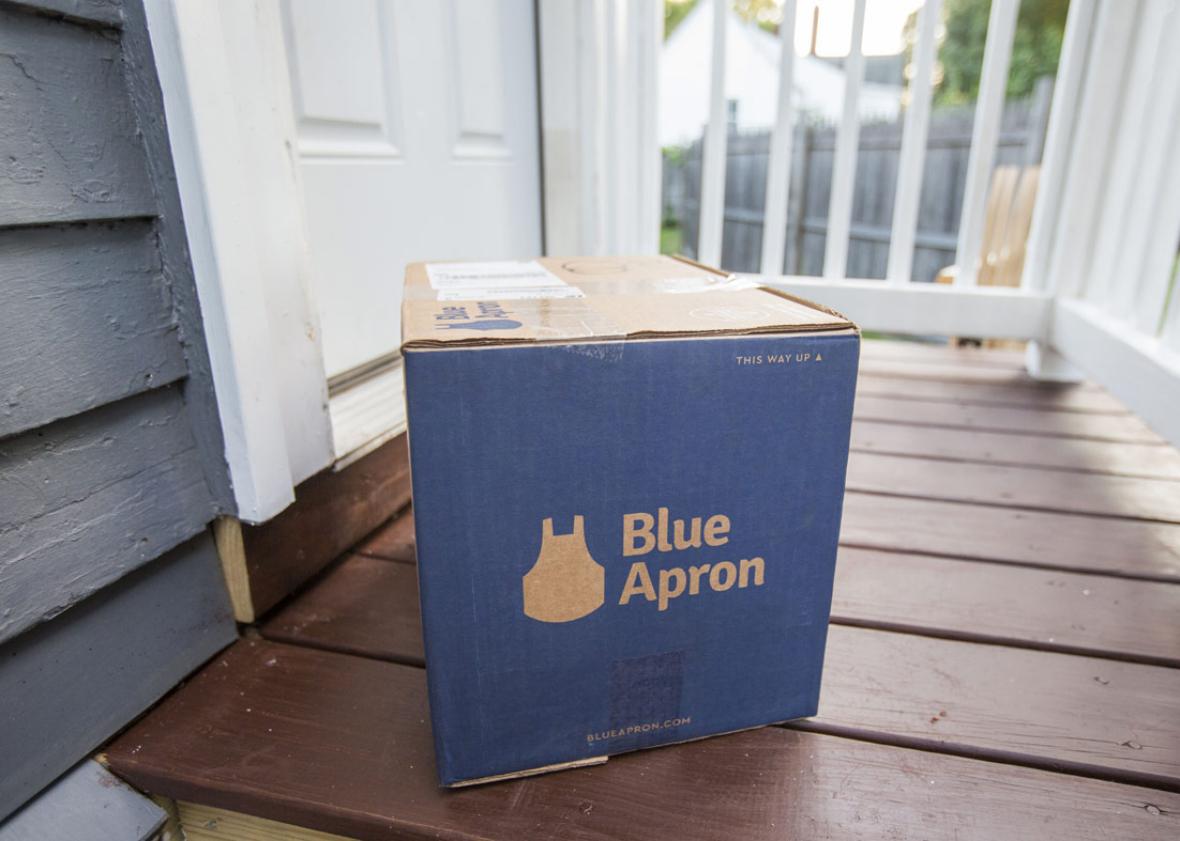E-commerce companies have a lot to fear from Amazon, and not just because the retail giant will always beat them on convenience and price. It’s also a prodigious maker of cheap knockoffs—and its latest clone looks a lot like Blue Apron’s meal kits.
On Monday GeekWire reported that the Amazon Meal Kit is now available in Seattle, with other markets likely on the way. Which means that Blue Apron, which started trading as a public company less than a month ago, is now competing with a retailer worth nearly $500 billion.
The basic idea behind Blue Apron—instead of schlepping to the grocery store, you get a box with portioned-out ingredients and some cooking instructions—has fueled a cottage industry of meal-kit startups. The appeal has been obvious: If you really enjoy cooking but can’t spare the time to go grocery shopping for fresh ingredients, subscribing to Blue Apron makes a lot of sense. The meal kit company now delivers about 8 million kits to U.S. homes every month.
Convenience, freshness, a culture-hopping menu, and a yuppie gloss are what Blue Apron has to offer. A low price point is not, though at the moment, Blue Apron and Amazon’s prices are comparable. Blue Apron charges about $10 a serving as part of a several-meal subscription. Amazon’s is a bit cheaper, ranging from about $8 and $10 a serving.
No matter what, having Amazon as a competitor is daunting, especially considering the company just bought Whole Foods and its 466 stores for a whopping $14 billion, signaling Amazon’s ambitions to shape the future of grocery shopping in a big way.
Blue Apron’s stock naturally took a hit on Monday when the news of Amazon’s meal kit made headlines. The company’s shares fell to $6.45, down 35 percent from the $10 a share it was trading when the company went public. Its stock has barely nudged upward since.
But just because Amazon is gunning to up its grocery game—it already sells all kinds of perishables with its Prime Fresh service—doesn’t mean that there’s no room for Blue Apron to make better meal kits and carve room for its business to thrive.
After all, Amazon hasn’t really figured out its grocery strategy yet. As of September, the company only accounted for less than 1 percent of the U.S. grocery business. And Whole Foods at that time only accounted for 1.7 percent of U.S. grocery sales, according to data from Bloomberg. For Blue Apron to survive where Amazon has decided to directly compete, it will probably have to position itself as the higher-quality, real-deal meal kit service, hoping that Amazon’s product looks like a cheap imitation in comparison, the grocery-store no-name cereal to its Cheerios.
So far, that problem hasn’t dogged Amazon, which has found success selling its own cheap Amazon-branded products—usually called Amazon Basics—like phone chargers, batteries, and laptop sleeves. Those are all products where price may matter a lot more than brand name. Amazon Basics now account for almost a third of all online battery sales and around 15 percent of online baby wipes sales, according to Mark Meeker’s influential 2017 internet trends report.
Still, food is different. Customers—or at least customers of Blue Apron, Purple Carrot, and Plated—often want high-quality, fresh, and local ingredients that are ethically sourced.
Is that enough for Blue Apron’s fans to renew their subscriptions once Amazon Meal Kit comes to their town—and to keep generating new customers?
Maybe not. For one, Amazon has its loyal Prime members. About 50 percent of U.S. households are Prime members, according to recent data from Piper Jaffray. If those members want to order a meal kit, they don’t have to open a new account with Blue Apron.
Then there’s Blue Apron’s subscription model, which requires people to buy into more than one meal, as opposed to Amazon’s meal kits, which Prime members can buy as single boxes without committing to a whole new meal-kit lifestyle.
Another thing Amazon has going for it: The online retailer can absorb a lot of failure. Meal-delivery companies, whether they sell kits or fully cooked dinners, produce a large amount of waste. Whatever doesn’t sell, spoils. Which means lots of overhead, careful planning, and little margin for error. A litany of on-demand meal delivery startups, each with millions in venture capital, have gone under in the past two years. SpoonRocket, Maple (which raised around $50 million), and Sprig ($56 million!) have all folded, likely due to high door-to-door delivery costs and the massive amount of food that has to be thrown or given away every day if it doesn’t sell. Amazon, meanwhile, is happy to lose money on a line of business in order to dominate a space.
And that’s the biggest difference between Amazon and Blue Apron, which are both betting that a lot of people like the idea of cooking food but not chopping it or shopping for it: If its Meal Kits don’t succeed, Amazon will be just fine. If Blue Apron’s offerings don’t make it, the whole business fails.
What other favored food items of time-strapped Americans will Amazon try to offer next? Amazon Pizza, Amazon Salad Bars, an Amazon knockoff of Soylent? That might be the perfect meal to offer Amazon customers who have no time to eat, much less shop for, real food.
